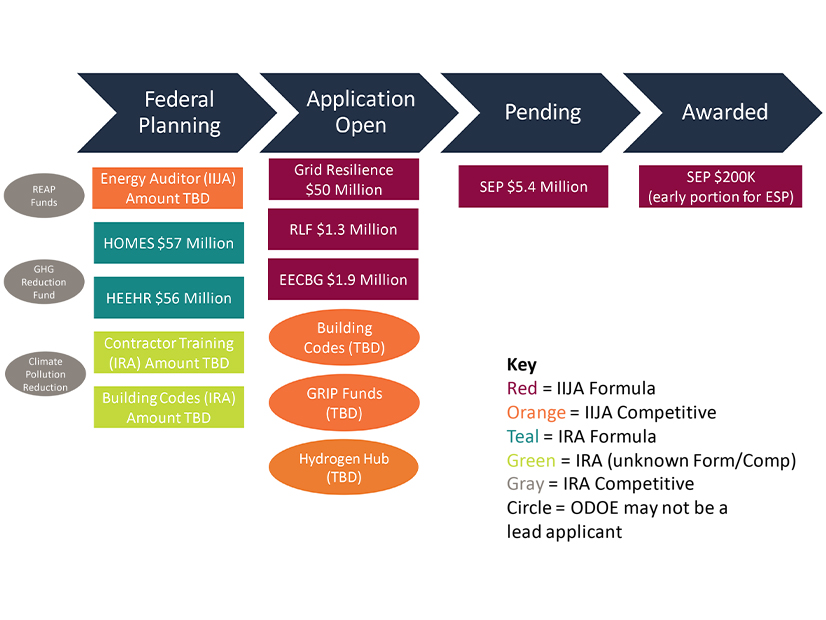
Oregon is eligible to rake in hundreds of millions of dollars in funding for building electrification, energy efficiency and grid resilience through federal grant and tax credit programs established over the past two years.
But so far, the state has received just $200,000 from the feds, despite Congress having passed the $1.2-trillion Infrastructure Investment and Jobs Act (IIJA) a year-and-a-half ago.
On Wednesday, Oregon Department of Energy (ODOE) Director Janine Benner appeared to counsel patience for the utilities, companies and other organizations looking to tap that funding stream.
“It takes time to get the money through the federal process, and it will take time to get the money through the state process, so I think a lot of folks are working as hard and fast as they can,” Benner said Wednesday during an agency webinar on the status of the state’s funding under the IIJA and the Inflation Reduction Act (IRA), which was passed last August. (See Senate Passes Inflation Reduction Act.)
The $200,000 already received was IIJA funding awarded under the U.S. Department of Energy’s State Energy Program (SEP) and is targeted at improvements to Oregon’s energy security plan. ODOE in December applied for the remaining balance of the $5.6 million in SEP formula funding available to the state under the IIJA, money to be used “to provide technical assistance to consumers and communities as well as to facilitate research, analysis and programs on energy efficiency, renewable energy, sustainable transportation, and resilient energy systems,” according to Jennifer Senner, ODOE’s federal grants officer.
Senner said Oregon is also preparing applications for:
- $50 million in IIJA formula funding for grid resilience, which the state must match at 15%. Utility recipients that sell more than 4,000,000 MWh annually will then be required to match their state grants at 100%, while those selling less than that amount must match at one-third.
- $1.3 million from the IIJA’s Energy Efficiency Revolving Loan Fund Capitalization Grant Program, which provides grants and loans to conduct commercial and residential energy audits and perform EE upgrades and retrofits of buildings.
- $1.9 million from the IIJA’s Energy Efficiency and Conservation Block Grant Program for projects that reduce home carbon emissions and improve energy efficiency.
Oregon will also be eligible for a total of $113 million in IRA formula funding under the HOMES program, which incentivizes contractors and installers for improving the energy performance of houses, and the High-Efficiency Electric Home Rebate (HEEHR) program, which offers cash to low- and moderate-income households that switch to electric heating and appliances (such as heat pumps), upgrade electric panels and wiring to accommodate new equipment, and improve their home’s energy efficiency.
“While there’s a lot we still don’t know about these funds, we anticipate we will be submitting an application for them either in the summer or the fall, and that the funds will be available in either late 2023 or early 2024 to support these residential upgrades related to homes,” Senner said.
ODOE is also exploring IRA programs related to workforce training, including the training of contractors who would assist in implementing the residential energy efficiency upgrades under the HOMES and HEEHR programs. Senner said it is still not clear whether those grants would be competitive or offered under formula funding for all states.
Senner noted that ODOE is participating with the Washington Department of Commerce and others in the Pacific Northwest Hydrogen Association (PNHA), which was created to win a portion of the $8 billion in funding the Biden administration is targeting for the development of regional hydrogen hubs across the country. The DOE has encouraged the PNHA to submit a full application for a matching grant after reviewing the association’s concept paper. (See DOE: 33 of 79 Preliminary Hydrogen Hub Applications Chosen.)
‘A Huge Opportunity’
Senner said Oregon is also seeking to tap money from the U.S. EPA’s Greenhouse Gas Reduction Fund, which was established to prompt private capital to finance GHG-reduction projects, and the Climate Pollution Reduction Grants program, which is targeted at states, territories, tribes, air pollution control agencies and local governments to implement emissions-reduction plans. She said Oregon might be able to get an early jump on this funding because it already has advanced GHG plans in place.
ODOE “will consider equity at every step” in the process of spreading the federal funds, including considering the “geographic diversity” of recipients, Benner said, referring to the state’s sharp urban-rural divide, partly a product of income disparities between wealthier metro areas and lower-income rural towns.
“We will try to coordinate with tribal governments, and we’ll work to communicate clearly, inclusively and efficiently to ensure stakeholders and the public are informed and supported and that they’re able to participate in federal funding opportunities,” she said. She added that the agency will take guidance from the Biden administration’s Justice40 initiative, which aims to distribute at least 40% of the funds to disadvantaged communities.
Senner said ODOE is still “waiting on quite a bit of guidance” from federal agencies on the various programs, particularly those related to the IRA.
“It’s a bit overwhelming with the amount of funding federal funding coming our way, but it’s a huge opportunity for the state to make significant progress on our clean energy and climate change goals,” Benner said.

